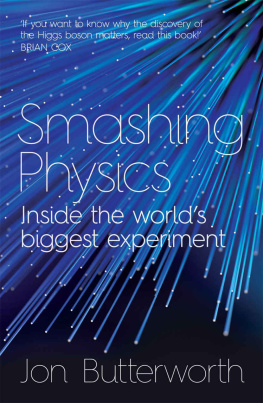Contents
About the Book
What is the universe really made of? How do we know? Follow the map of the invisible to find out
Over the last sixty years, scientists around the world have worked together to explore the fundamental constituents of matter, and the forces that govern their behaviour. The result, so far, is the Standard Model of elementary particles: a theoretical map of the basic building blocks of the universe. With the discovery of the Higgs boson in 2012, the map as we know it was completed, but also extended into strange new territory.
A Map of the Invisible is an explorers guide to the Standard Model and the extraordinary realms of particle physics. After shrinking us down to the size of a sub-atomic particle, pioneering physicist Jon Butterworth takes us on board his research vessel for a journey in search of atoms and quarks, electrons and neutrinos, and the forces that shape the universe. Step by step, we travel into the world of the unseen, discovering phenomena both weird and wonderful, from atoms to black holes and dark matter, and beyond, to the outer reaches of the cosmos and the frontiers of human knowledge.
Beautifully illustrated, with gradually evolving maps offering an inventive visual glossary as the journey progresses, A Map of the Invisible provides an essential introduction to our world, and to particle physics. It is a landmark work of non-fiction by one of the great scientists and science writers of today.
About the Author
Jon Butterworth is currently Head of the Department of Physics and Astronomy at UCL and works on the ATLAS Experiment at CERN's Large Hadron Collider. He studied at the University of Oxford, receiving a DPhil in particle physics in 1992. He is the author of Smashing Physics, and of the Life and Physics blog for the Guardian. He lives in London.
Also by Jon Butterworth
Smashing Physics
A MAP OF THE INVISIBLE
Journeys into Particle Physics
Jon Butterworth
To Ann and Keith
A Note on the Maps
THE MAPS WITHIN this book should be seen as an aid to memory, rather than a detailed representation of particle physics. There is a rough direction of increasing energy (and decreasing size) from west to east, and increasing complexity from south to north, but there are grey areas and ambiguities. Sometimes the energy scale is binding energy, sometimes mass, and there are unavoidable inconsistencies even so. For example, the photon belongs on Bosonia in the east, even though its presence is felt far to the west. The tau and muon should arguably be further east than the up, down and strange, based on their masses, although one does really have to cross Lamdba QCD to get to the quarks. Allegory and analogy can help understanding, but are misleading if pushed too far. Enjoy yourself but tread with care.
PROLOGUE
The Journey Begins
CONSIDER A THOUGHT experiment: take an apple and cut it in half, then cut it in half again, and again, and keep doing that. What will you end up with?
Or, less destructively, peer more and more closely into an apple: what structure is revealed? Is everything made up of a small set of common constituents call them elements, or atoms arranged in various different ways? If so, what happens if I look more closely at those constituents? Are they made of something even smaller?
What is eventually revealed is a landscape. A landscape inhabited by strange and wonderful particles. In this landscape are islands of complexity linked by networks of communication, emerging from the oceans of our ignorance. The landscape starts from everyday life, with an apple, for example, and extends to the wild frontier of the almost impossibly small.
To get from an apple to the impossibly small, we will need to set sail. We will need a boat, a craft which will stand for the microscopes, accelerators and other machinery that extend our vision beyond the capacity of the naked eye and into the heart of the atom and beyond. How far can we sail? Is there an end to this invisible world? Are there indivisible particles, of which everything else is made, or can we carry on forever, finding ever-smaller stuff, sailing ever further eastwards? These questions have been discussed for millennia, and addressing them is one of the goals of physics. The answers, as far as we know them, are found in the strange, invisible landscape that we will explore and map in this book.
The Name of the Game
The science of the very smallest things is commonly called particle physics. No name is perfect, and this one is confusing in a number of ways.
The word particle is potentially misleading. Physicists study particles of sand, pollutants, dust in space and in the atmosphere and other small clumps of stuff, which have nothing directly to do with the ultimate constituents of matter.
Sometimes particle physics is called elementary particle physics to distinguish it from the study of these composite particles. But this isnt much help, since protons and neutrons important, tiny particles which are crucial features in the landscape of the subject arent elementary. At some point we may even find out that the fundamental particles of our current theories arent elementary either, although studying them is definitely particle physics. Elementary particle physics is also disfavoured as a term for research groups or university courses because it makes the subject sound too easy. A student who enrolled on an Elementary Particle Physics course might get a shock when confronted with the equations relating to the particles we will be searching for.
High-energy physics is a commonly used alternative, and it is true that the direct approach to particle physics basically, smashing things together in huge colliders to see what happens involves a lot of energy. But some of the key experiments actually rely on hunting for very, very rare, very low-energy particles. Physicists hide their detectors deep underground to try to evadetiny amounts of noise, and every ultra-low-energy jitter is a cause for annoyance or excitement. Indirectly, these experiments do tell us something about what goes on at high energies, but calling them high-energy physics somehow seems a bit inappropriate.
Another problem with high-energy physics as a name is that nuclear physicists, astrophysicists, plasma physicists and many more all deal with energies that are much higher than those used to probe the limits of particle physics. The energy of a collision in the Large Hadron Collider, which at the time of writing is the highest-energy particle collider ever built, is tiny compared to the energy that is released in a functioning nuclear reactor, which itself doesnt even register when compared to an exploding star.
Whatever the name we give the subject, the investigation is a practical one, liberated from the realms of speculative philosophy by experiments, beginning with the human eye, then the microscope, and continuing with powerful particle accelerators and other precision instruments. Each new generation of experiments opens up to human enquiry new landscapes of the very small, and lets us make maps to guide the way deeper into the heart of matter.
But in the end, the question is the same, then and today: what is the universe made of, really, when you get right down to it?
The Standard Model
The current answer is encapsulated in a theory going by the understated (frankly, dull) name of the Standard Model, which summarises the current state of our knowledge of the fundamental forces and constituents of matter the area of science generally known as particle physics. This is a theory (it is really more of a theory than a model, although the terms mean different things to different people) that is the product of many decades of work and research, and successfully describes a vast range of physical phenomena.











